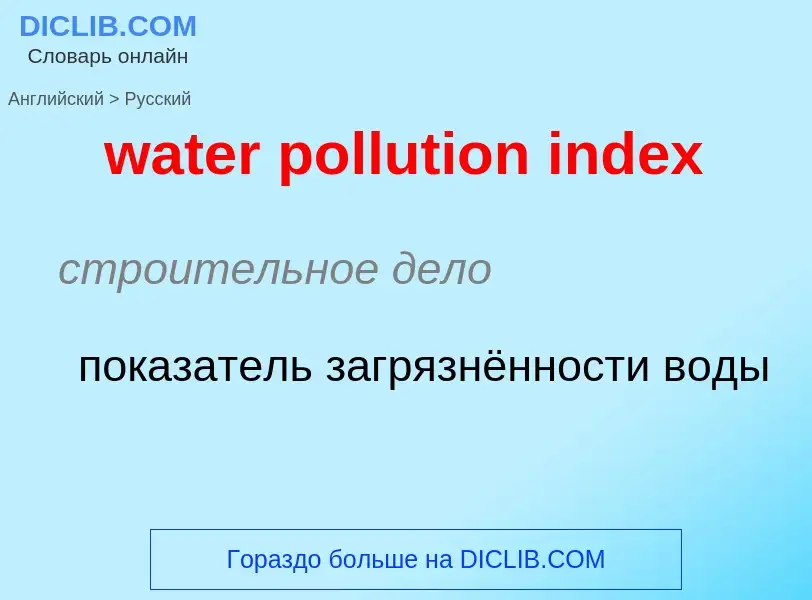Translation and analysis of words by ChatGPT artificial intelligence
On this page you can get a detailed analysis of a word or phrase, produced by the best artificial intelligence technology to date:
- how the word is used
- frequency of use
- it is used more often in oral or written speech
- word translation options
- usage examples (several phrases with translation)
- etymology
water pollution index - translation to russian
строительное дело
показатель загрязнённости воды
[pə'lu:təntstændəd'indeks]
американизм
стандартизированный показатель степени загрязнённости воздуха
показатель качества воздуха
Definition
Wikipedia
Water pollution (or aquatic pollution) is the contamination of water bodies, usually as a result of human activities, so that it negatively affects its uses.: 6 Water bodies include lakes, rivers, oceans, aquifers, reservoirs and groundwater. Water pollution results when contaminants mix with these water bodies. Contaminants can come from one of four main sources: sewage discharges, industrial activities, agricultural activities, and urban runoff including stormwater. Water pollution is either surface water pollution or groundwater pollution. This form of pollution can lead to many problems, such as the degradation of aquatic ecosystems or spreading water-borne diseases when people use polluted water for drinking or irrigation. Another problem is that water pollution reduces the ecosystem services (such as providing drinking water) that the water resource would otherwise provide.
Sources of water pollution are either point sources or non-point sources. Point sources have one identifiable cause, such as a storm drain, a wastewater treatment plant or an oil spill. Non-point sources are more diffuse, such as agricultural runoff. Pollution is the result of the cumulative effect over time. Pollution may take the form of toxic substances (e.g., oil, metals, plastics, pesticides, persistent organic pollutants, industrial waste products), stressful conditions (e.g., changes of pH, hypoxia or anoxia, increased temperatures, excessive turbidity, changes of salinity), or the introduction of pathogenic organisms. Contaminants may include organic and inorganic substances. A common cause of thermal pollution is the use of water as a coolant by power plants and industrial manufacturers.
Control of water pollution requires appropriate infrastructure and management plans as well as legislation. Technology solutions can include improving sanitation, sewage treatment, industrial wastewater treatment, agricultural wastewater treatment, erosion control, sediment control and control of urban runoff (including stormwater management).

![A polluted river draining an abandoned [[copper mine]] on [[Anglesey]] A polluted river draining an abandoned [[copper mine]] on [[Anglesey]]](https://commons.wikimedia.org/wiki/Special:FilePath/AngleseyCopperStream.jpg?width=200)
![Bauxite residue]] is an [[industrial waste]] that is dangerously alkaline and can lead to water pollution if not managed appropriately (photo from [[Stade]], Germany). Bauxite residue]] is an [[industrial waste]] that is dangerously alkaline and can lead to water pollution if not managed appropriately (photo from [[Stade]], Germany).](https://commons.wikimedia.org/wiki/Special:FilePath/Bützflethermoor Rotschlammdeponie Luftaufnahmen 2012-05-by-RaBoe-478-1.jpg?width=200)
![Solid waste and plastics in the [[Lachine Canal]], Canada Solid waste and plastics in the [[Lachine Canal]], Canada](https://commons.wikimedia.org/wiki/Special:FilePath/Canal-pollution.jpg?width=200)

![Fecal sludge]] collected from pit latrines is dumped into a river at the Korogocho slum in [[Nairobi, Kenya]]. Fecal sludge]] collected from pit latrines is dumped into a river at the Korogocho slum in [[Nairobi, Kenya]].](https://commons.wikimedia.org/wiki/Special:FilePath/Dumping of faecal sludge into the river.jpg?width=200)
![[[Oxygen depletion]], resulting from [[nitrogen pollution]] and [[eutrophication]], is a common cause of fish kills. [[Oxygen depletion]], resulting from [[nitrogen pollution]] and [[eutrophication]], is a common cause of fish kills.](https://commons.wikimedia.org/wiki/Special:FilePath/Fish Kill 745F2A9C-65B8-D693-7ABA3282F6A1ECE4.jpg?width=200)
![Environmental scientists]] preparing water autosamplers Environmental scientists]] preparing water autosamplers](https://commons.wikimedia.org/wiki/Special:FilePath/Research- water sampling equipment.jpg?width=200)
![View of secondary treatment reactors (activated sludge process) at the [[Blue Plains Advanced Wastewater Treatment Plant]], Washington, D.C., United States. Seen in the distance are the sludge digester building and thermal hydrolysis reactors. View of secondary treatment reactors (activated sludge process) at the [[Blue Plains Advanced Wastewater Treatment Plant]], Washington, D.C., United States. Seen in the distance are the sludge digester building and thermal hydrolysis reactors.](https://commons.wikimedia.org/wiki/Special:FilePath/Secondary treatment reactors - Blue Plains WWTP - 2016b.jpg?width=200)
![[[Silt fence]] installed on a construction site [[Silt fence]] installed on a construction site](https://commons.wikimedia.org/wiki/Special:FilePath/Silt fence EPA.jpg?width=200)


